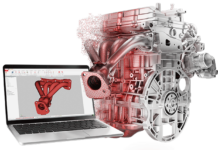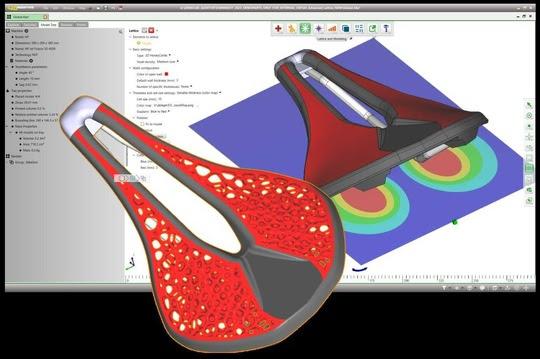Software pioneer CoreTechnologie has upgraded the latest version of its 3D printing software 4D_Additive with a new lattice structure module. The new functions are used to create individualised structures that enable a customised production of lightweight mechanical components and consumer goods.
The new 4D_Additive software version 1.5 from the Franco-German software manufacturer CoreTechnologie features a completely revised lattice structure module. With the help of the new functions, complex geometries for the additive manufacturing of lightweight mechanical components and consumer goods can be created quickly, easily and in a customised way. For example, shoes and bicycle saddles can be customised to meet individual customer requirements. The new software version thus takes 3D printing to the next level in terms of customised production.
Optimised Geometry Generation
Thanks to the software’s new lattice structure functions, additively manufactured components with additional properties such as progressive damping, highly efficient heat exchange, lightweight design or functions of an assembly integrated into a single component can be quickly developed and optimised. The cell size and grid thickness of the structures can be adapted to the load profile using a colour graphic so that the areas with higher loads are adaptively generated with a denser structure. The software’s Nastran interface enables the seamless transfer of data to CAE calculation systems to validate the geometries generated in seconds.
Structural Lightweight Construction
With 22 different grid types, internal and external grids are generated on the basis of the original 3D/CAD models. Individual surface areas or parts of the component volume are quickly and easily replaced with lightweight and high-strength structures such as gyroids or Stochastk Voronoi, optimising the CAD model for the respective application.
Perforation Pattern
The simple creation of perforation patterns is possible with the help of new Boolean functions. Thousands of holes of any size are automatically generated so that they are perpendicular to the surface of the CAD model. Interesting applications for the 3D-Printing lattice technology include, for example, additively manufactured moulds for Vacuum thermoforming or the production of catalytic converters.
Functions for generating parts with lattice structures of different densities, which are manufactured using additive processes, are going to change the way products are developed and improve the performance of many products.
About CoreTechnologie
The Software manufacturer CoreTechnologie founded in 1998 is headquartered in Frankfurt/Germany and has subsidiaries in France, Japan, and the USA. The company is the leading provider of 3D Computer-Aided Design (CAD) translation software, known as 3D_Evolution™ (conversion, repair, simplification, analysis), 4D Additive™ (3D printing software suite), 3D_Analyzer™ (CAD viewer with analysis tools) and 3D_Kernel_IO (CAD interfaces SDK). The mission of the company is to optimize seamless MCAD interoperability in the value chain and to develop customized solutions for PLM integration and process automation. The customer portfolio of CoreTechnologie includes 600 leading companies in the automotive, aerospace, mechanical engineering, and consumer goods industries, worldwide.



















